
Artist Kate Hunt sculpts powerful forms from pliable newsprint CORY WALSH cory.walsh@missoulian.com Mar 26, 2016 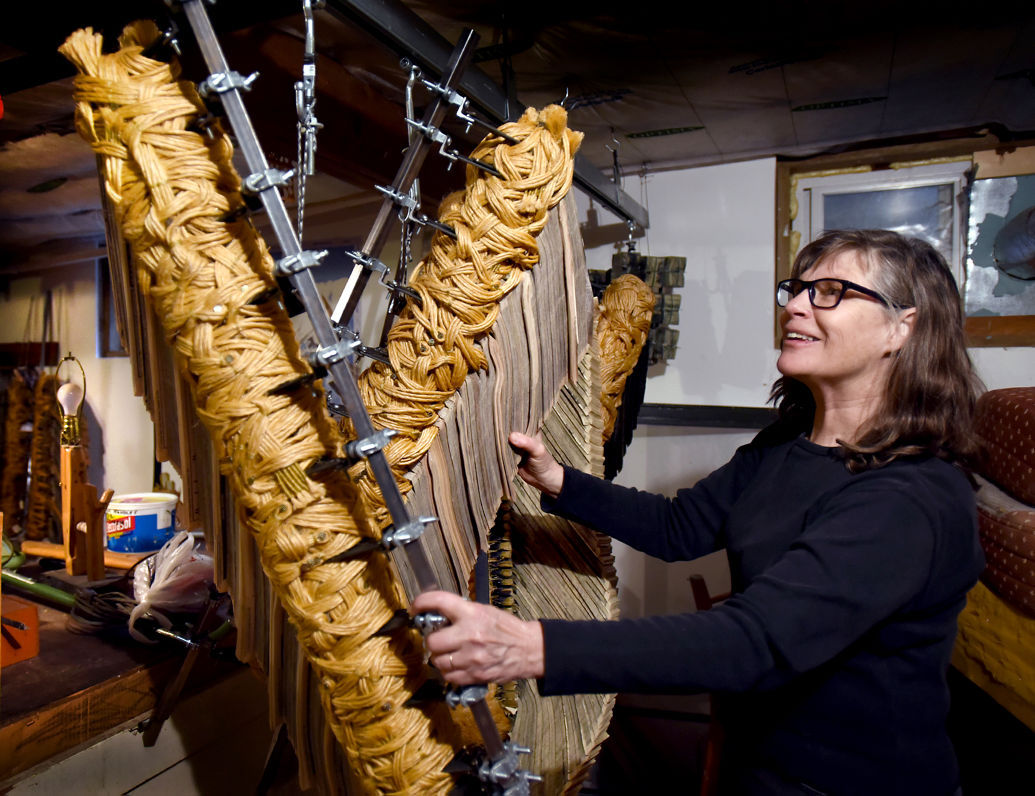
Creston sculptor Kate Hunt, a native of Chester, keeps her series of Torringtons,abstract sculptures made of newspaper, baling twine and steel, hanging in a basement room of her home when they not being shown in art museums. 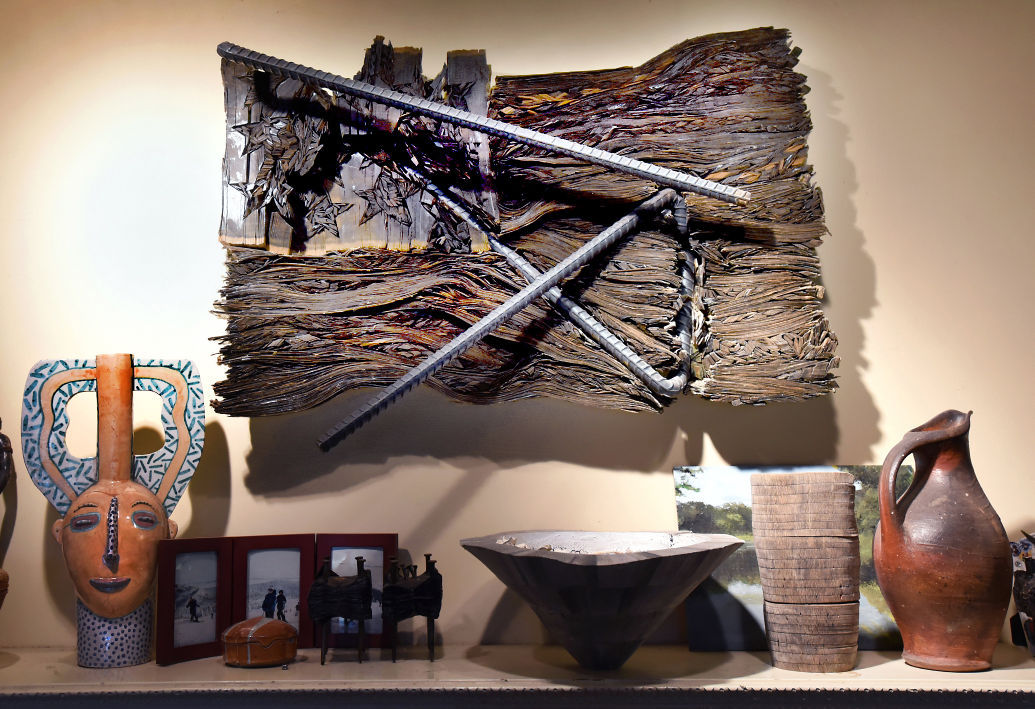
Hunt's flags are some of her most popular works for buyers. This one, made during the Clinton inauguration, hangs in a prominent spot above the fireplace mantel lined with other work she has made or collected. 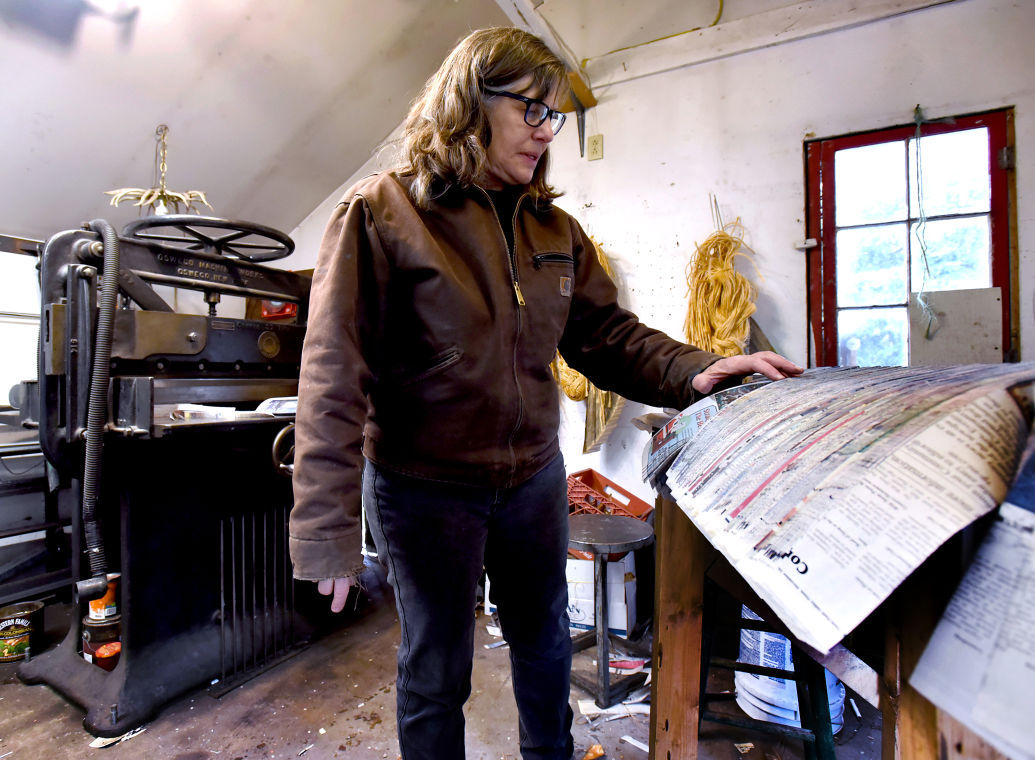
Hunt uses a 1900s Oswego Machine Works paper cutter that she bought 25 years ago in Townsend to slice the newsprint before assembly. "It just gives itself to me," she says of the paper. "It's a vehicle I use to convey my ideas.' 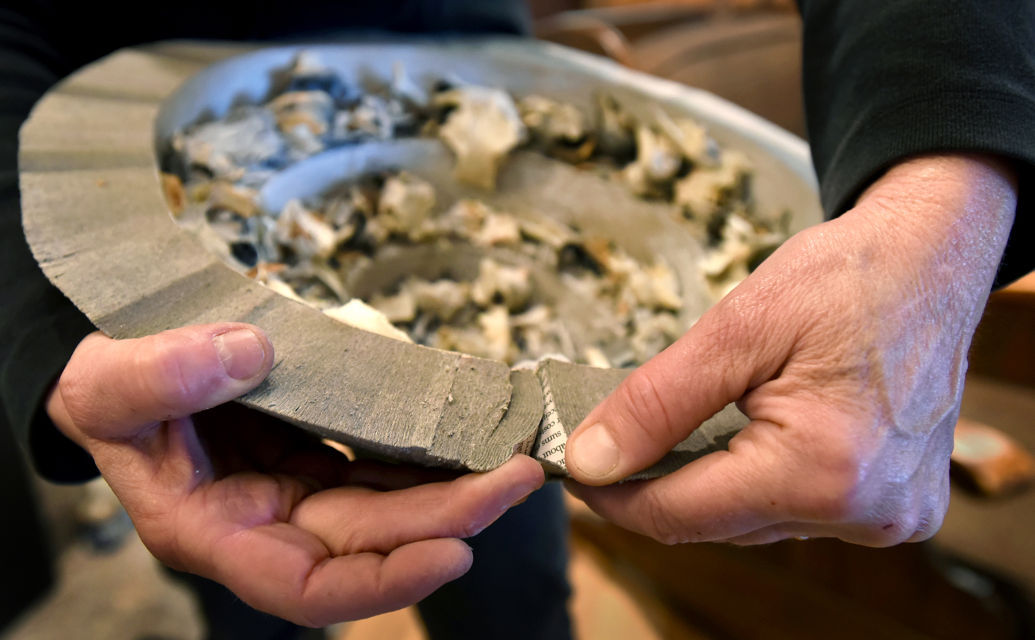
A terraced paper bowl appears from a distance to be made of stone. 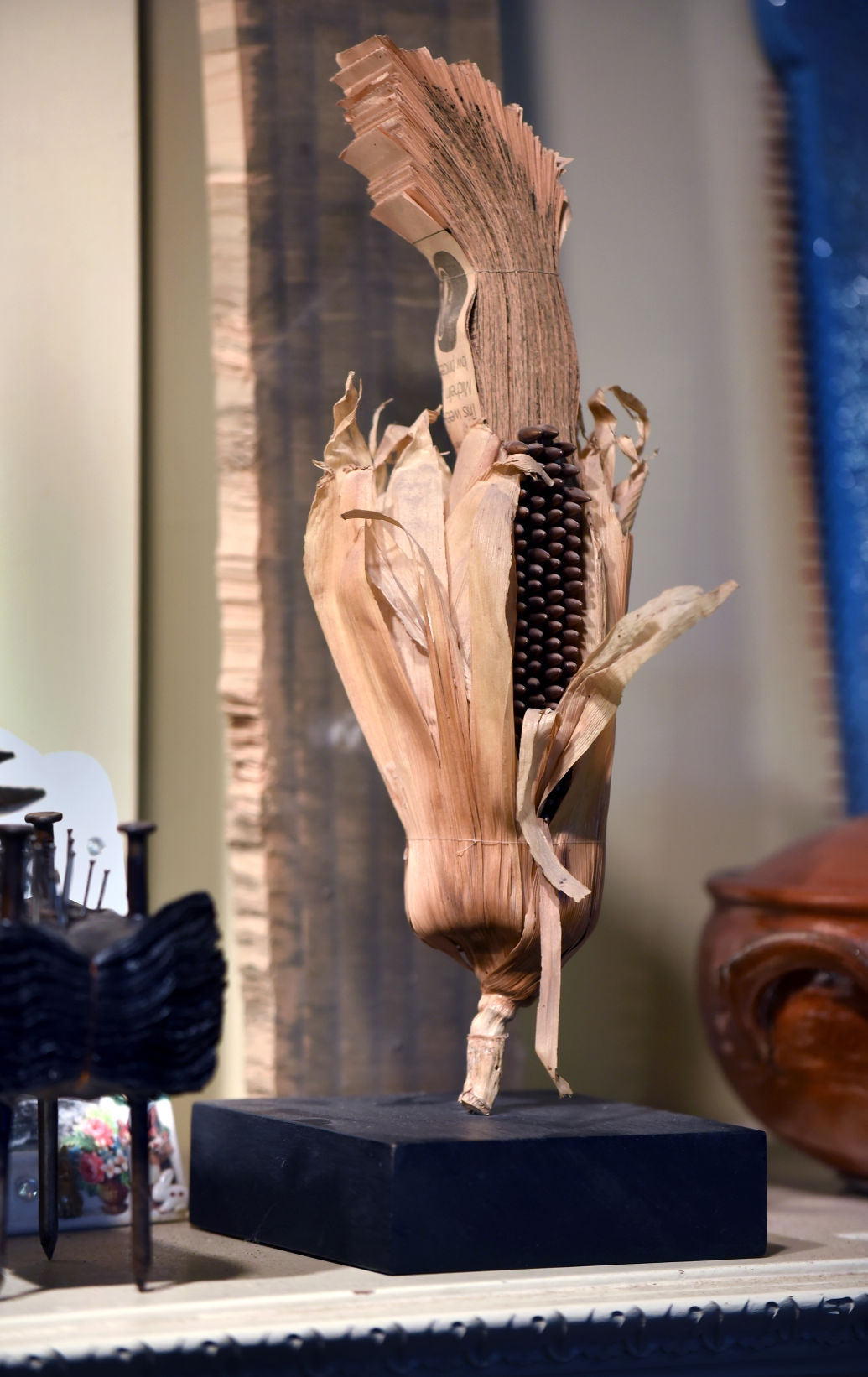
A corn stalk made of newsprint is one of Hunt's earliest pieces in the medium. 
Sitting on a "floor mat" she created and uses as an entrance to her studio, Hunt cuddles up with Reena, a dog she occasionally watches for a friend. "It's more about being one with the world," she says of her art, "more than trying to read the outside world." 
Hunt adjusts one of a pair of columns leaning against a pine tree on the property she and her husband, Todd Johnson, a commercial fisherman, have lived on for 28 years just south of the center of Creston. Photos: KURT WILSON, Missoulian CRESTON - Some pieces of art haven't outlasted their written descriptions, the work itself destroyed or lost while its memory lived on courtesy of paper. Kate Hunt's sculptures will have a long life, though, because they're made of newsprint. No one thinks of it as an archival material, but Hunt has made it the main construction material for her art for decades now. By one estimate she found, newsprint that's stacked so that it's less exposed to air and light will only lose one-eighth of a inch every hundred years. Its durable nature and pliability appeal to Hunt, who uses yesterday's news to build diverse bodies of work: columns 10 feet high and 5.5 inches square that weigh 80 pounds. She stacks them into walls or lays them on museum floors in rows. She cuts newsprint into strips with a turn-of-the-century paper guillotine and assembles flags, often covered with wax and charred to create a startling palette of blacks and browns. She builds abstract forms she's nicknamed Torringtons, which resemble an artifact from heretofore unknown culture. It's a medium she has yet to exhaust. "It just gives itself to me," she said. "It's a vehicle I use to convey my ideas." Not only is it forgiving, but its muted range of color, white when fresh, grayed with time or blackened when burned with a torch, resemble the subtle, powerful landscape in her childhood home of Chester. To her, color always returns to "the Montana plains palette," she said. *** For the last 28 years, Hunt has been exploring the potential for paper at her home studio in Creston, just 10 miles north of Bigfork on Montana Highway 35. She keeps some of her earliest pieces on the property, a circa 1940s home surrounded by state farm land. Her first floor piece from the early 1980s, made for a show at the Brunswick Gallery on Railroad Street, is one of the first sculptures a visitor sees when entering her home. In one of her many working spaces hangs the first flag she constructed, shortly after moving here with her husband, Todd Johnson, and their two children. The first Torrington, a primal, shield-like form, hangs in the hallway near Todd's office. From those earliest pieces, Hunt built a body of work that's continually attracted the attention of the outside art world. She points to a few column sculptures in the yard near her studio, which were featured in the New York Times back in 1995 for a feature on rural artists and the National Endowment for the Arts. Her work is now part of prestigious private and corporate collections around the world. Locally, it's been exhibited at the Missoula Art Museum, and last December she was selected for an Artist's Innovation Award from the Montana Arts Council, which acknowledges individuals for their originality and dedication. Last year, she displayed her work at the Portland Art Museum, to name just one of the out-of-state exhibitions. Mariam Diehl first saw Hunt's work in the Amangani Resort in Jackson, Wyoming, where she said Hunt's works were "beautifully and prominently displayed all over the hotel." "I love the mixed mediums and textures of Kate Hunt's work. I've seen artists work in newspaper before, but never quite like this," she said. About four years ago, Diehl signed up Hunt as one of her artists at the Diehl Gallery, also in Jackson. "Kate's a remarkably humble artist. She creates outstanding work that takes physical strength and tremendous creativity," she said. *** Building sculptures like Hunt's takes time, space and some heavy machinery. In her unattached studio lie the raw materials and equipment required. One of those is an early 1900s Oswego Machine Works paper cutter that Hunt bought some 25 years ago in Townsend. She plugs it in, sets a stack of the Kalispell Daily Inter Lake onto the bed. The 32-inch guillotine neatly slices the paper into thick, densely packed strips that form the building blocks of her art. Over in the corner, stacked halfway to the ceiling are bound copies of the Jackson Hole News. They date back to the 1970s, and Hunt bought them when the newspaper was unloading hard copies of its library. She also buys up copies of the Congressional Record and drives to Kalispell to pick up copies of the Inter Lake by the pickup truckload. Her work requires welding tools and drills - the columns are held in place by threaded steel rods. In the basement of the home, she keeps another studio where she assembles some sculptures. A flag in progress rests on a table, where she's arranging the pliable newsprint into stripes. Hunt was influenced by sculptors like Dale Eldred, Chakaia Booker, Magdalena Abakanowicz and Mark di Suvero, but said she remains fairly isolated. "It's more about being one with the world, more than trying to read the outside world. Of course we're all influenced by the outside world, there's no question about that. But you tunnel in, you tunnel into the work and one thing leads to another," she said. On the floor is a massive drawing in progress, another body of work she's exploring. Nearby are the finished Torringtons, stark constructions arranged into diptychs or higher numbers. She builds them from wave-like strips of newsprint attached to a spine of threaded baling twine held upright by steel rods. They're named after John Shaw Torrington, the explorer who died on an expedition of the Northwest Passage. When she was building one of the first, a newspaper article about the discovery of his mummy and an accompanying photograph popped up on one of the pages in the sculpture. The Torringtons are pure abstractions with ambiguous titles, which allows viewers to read whatever they like into them. Diehl said people often see a Native American aspect to her work, although "that's not really her impetus." Hunt also built her first flag not long after moving to Creston. One large flag, blackened and adorned with bent Rebar, hangs above the fireplace in her living room. They're not political statements, she said, nor should they be read as violent. "This is all about color," she said, citing the shades of black and brown within the paper, the boat-building epoxy and Rebar. The anthropologist Claude Levi-Strauss was a large influence on her, particularly his ideas about how viewers bring their own history and relationship with materials to a piece of work. The viewers' personal histories with her materials, she said, add an air of timelessness to the pieces. She likes to explain our relationships to art with a triangle art. On one side is the art and the artist: She in her studio asking questions and trying to resolve them, almost like a conversation. "Then when it's finished, I send it out into the world and it becomes a relationship between the art and the audience," she said. She doesn't feel she's a part of that conversation. It's "one that I'm curious about, but in a way it's not my business," she said. Then there's the relationship between the artist and the audience, at gallery openings or interviews, or the occasional visitor who wants to see her studio. A man from Germany and his father are coming over for a tour soon. "I get these people who show up on my doorstep cause of my webpage," she said. *** Hunt grew up in Chester, the seat of Liberty County, up along the Canadian border. Her father, William Hunt Sr., was county attorney there. (He later went on to help form the Montana Consumer Counsel to fight a rate increase from the monopoly utility Montana Power Co. and serve as a justice on the state Supreme Court.) The small town had an outsized exposure to the arts, courtesy of a doctor from Boston and other residents who imported contemporary culture to the town. The town of some 900 is also home to composer and pianist Philip Aaberg, who's earned national recognition for his work. She said that little town on the knoll had a certain air to it. "We were in the center of the universe, and we are," she said. Hunt, a twin and one of five kids total, said her parents raised them to be confident in themselves. "Dad would say, 'My father was a farmer so I could be lawyer so you could be an artist,' " she said. They moved to Helena when she was 13, and she graduated from the first class at Capitol High School. After a year at college at the University of Montana, she was accepted at the Kansas City Art Institute. She originally was a ceramicist and stayed with the medium through her senior year, when sculpture professors began telling her she was in the wrong department. She switched her emphasis and stayed for an extra year to study under sculptor Dale Eldred. A project making a paper-trap introduced her to working with newspaper, which translated into weavings and a lifelong fascination with the material. After earning her master's at the Cranbrook Academy of Art in Michigan, she returned to Montana, met her husband and began building her family and career. *** Hunt said she's reached a phase where "one idea sparks 10 more." She's more comfortable now than she was in her 30s, when she briefly considered quitting for a few days at a time. With a compulsion to build art, she'd shrug off doubts and continue her work. Before the Diehl Gallery, Hunt was trying to represent herself and found it difficult to do both. "Selling and building are just two different things," she said, crediting Diehl for her hard work. "She does such a great job of representing my work and making sure it gets into the right places," she said. She's been invited to residences in Mexico, and has one coming up for the American Prairie Reserve, which she thinks will take her back to her childhood roots on the plains. "You're the biggest thing on your horizon," she said, which gives you permission to focus on yourself. "It's this conversation you have with the world around you. It's not about other people telling you what to do. You've got to figure it out yourself," she said. On her mantle sits a bowl that from a distance appears to be ceramic. It's made from small squares of stacked newspaper carefully formed into curved layers. The edges of the paper face outward, giving it a feathery touch that's surprising due to its stone-like appearance. This piece is filled with cremated animal bones, sent to her by a veterinary relative in Idaho. She likes the beautiful all-white appearance of the bones, which have a contemplative air that's not at all morbid. She rarely says what a particular piece means to her, but when holding the bowl and gently re-arranging the bones, she offers a brief sentiment: It's about journeys. |